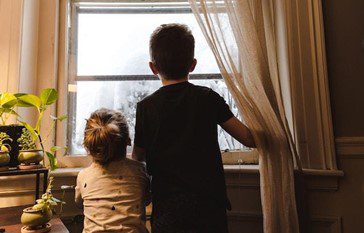Organizing for a Growing Family: Adapting Spaces as Your Family Grows

My guest blogger today is Emily Mitchell. She is a passionate mother, blogger, and interior design enthusiast. With a keen eye for creating stylish yet family-friendly spaces, she shares her insights and inspirations to help other parents make their homes beautiful and functional.
The journey of family life is a beautiful and rewarding one. However, as your family grows, so do the challenges and the need to adapt your living spaces. From welcoming a new baby into your home to watching your children grow into school-age individuals, the dynamics of your family spaces will continuously evolve. Let’s explore the art of organizing for a growing family, offering insights, tips, and creative solutions to ensure your home remains a comfortable and functional haven for everyone.
The Evolution of Family Spaces
From a Couple to a Family
One of the most significant changes in a couple’s life is the arrival of a baby. This transition often involves converting a spare room into a nursery. To make the best use your nursery space, consider multi-functional furniture like cribs with built-in storage or changing tables that double as dressers. Safety is paramount, so baby-proofing measures such as outlet covers, cabinet locks, and corner guards should be installed.

The Toddler and Preschooler Years
As your child grows, so does their need for space to explore and play. Designating a playroom can help contain the toys and mess while creating an environment for learning and imagination. Organize toys by type and use storage solutions like bins and shelves to keep them accessible yet tidy. Creating educational spaces within the home, like a reading nook or art corner, encourages cognitive development and creativity. Consider storing away some toys and changing the toys that are out on a regular basis. This makes cleaning up much easier.
School-Age Children
Once your child enters school, the home’s organization shifts again. Homework and study areas become essential. Provide a quiet, well-lit study space, and consider ergonomic furniture to promote good posture. Develop your child’s responsibility by involving them in organizing their study materials and belongings. Additionally, storage solutions should evolve to accommodate changing interests, hobbies and the child’s growth.
Maximizing Space Efficiency
Decluttering and Organizing
The key to efficient space utilization is decluttering regularly. Start by purging items your family no longer needs – organize belongings by category and invest in storage containers and systems that make it easy to maintain order. Implementing daily and weekly cleaning routines can help keep spaces clutter-free.
Multi-Functional Furniture and Design
In smaller homes or rooms with limited space, multi-functional furniture is a game-changer. Consider items like sofa beds, fold-down desks, or ottomans with hidden storage. These pieces save space and also add versatility to your rooms. Get creative with room layouts to maximize functionality while maintaining aesthetics.

Vertical Storage Solutions
Don’t neglect the vertical space in your home. Install shelves, hooks, or pegboards on walls to keep frequently used items accessible. Vertical storage can be very helpful in kitchens, home offices, and bathrooms. It reduces clutter and also adds an element of design to your spaces.
Creating Personalized Spaces
Designing Rooms for Individual Preferences
As your children grow, their personalities and interests evolve. Allow them to express themselves by personalizing their bedrooms. Incorporate their favourite colours, themes, and hobbies into the room’s design. This personal touch fosters a sense of ownership and comfort.
Encouraging Family Involvement
Family spaces should reflect the collective identity of your household. Encourage family members to participate in decorating projects. Collaborative efforts, such as creating a family photo wall or painting a mural together, strengthen the sense of togetherness in your home.
Adapting space in a family home after moving
After a move, reshaping the family home involves a mix of excitement and challenges. As you settle in, it’s a chance to re-envision your living spaces to suit your family’s needs and preferences better. Explore versatile furniture arrangements, declutter for a well-organized environment, and personalize rooms to reflect your family’s unique identity.
Another important step when moving with family is hiring assistance, so you might want to trust the process to specialists who will ensure a smooth transition. As you focus on envisioning your new living space, professionals can do all the planning and hard lifting. With the right moving professionals by your side, you can transform your new house into a warm and welcoming home.
Budget-Friendly Approaches
DIY Projects and Upcycling
Organizing for a growing family doesn’t have to break the bank. Consider do-it-yourself (DIY) projects and upcycling. Repurpose existing furniture or give it a fresh coat of paint to match your evolving decor. Creative and cost-effective ideas can be both fun and budget-friendly.

Smart Shopping Strategies
When you do need to purchase new furniture or decor, adopt smart shopping strategies. Look for budget-friendly options that still meet your quality and style preferences. Keep an eye out for seasonal sales, discounts, and online deals to make the most of your budget. Declutter and organize first. You may be surprised how few things you need to purchase.
Future-Proofing Your Home
Planning for the Future
Your family’s needs will continue to change over time. Plan for the future by creating adaptable spaces and space-saving solutions. Consider how rooms can evolve to accommodate different life stages, from toddlers to teenagers. Think about accessibility as family members age, ensuring that your home remains safe and functional.
Maintenance and Durability
Invest in durable materials and design choices that can withstand the wear and tear of family life. Easy-to-maintain surfaces, stain-resistant fabrics, and furniture with removable, washable covers can make your life easier as your family grows.
Conclusion
Organizing for a growing family is a dynamic process that requires flexibility and creativity. As your family evolves, so too must your living spaces. From welcoming a new baby to supporting school-age children, organizing and adapting your home is a rewarding endeavour. Remember, there’s no one-size-fits-all solution; your family’s unique needs and preferences should guide your choices. Maximizing space efficiency and creating personalized spaces can ensure that your family’s living spaces remain functional and welcoming for years to come. Embrace the journey of family life, and let your home evolve with you.
Share a way you adapted your home to suit your growing family.

Julie Stobbe is a Trained Professional Organizer and Lifestyle Organizing Coach who brings happiness to homes and organization to offices, virtually using Zoom. She has been working with clients since 2006 to provide customized organizing solutions to suit their individual needs and situations. She uses her love of teaching to reduce clutter, in your home, office, mind and time. She guides and supports you to be accountable for your time, to complete projects and reach your goals. If you’re in a difficult transition Julie can coach you to break-free of emotional clutter constraining you from living life on your terms. Online courses are available to help instruct, coach and support your organizing projects. Get started by downloading Tips for Reorganizing 9 Rooms.
Contact her at julie@mindoverclutter.ca

